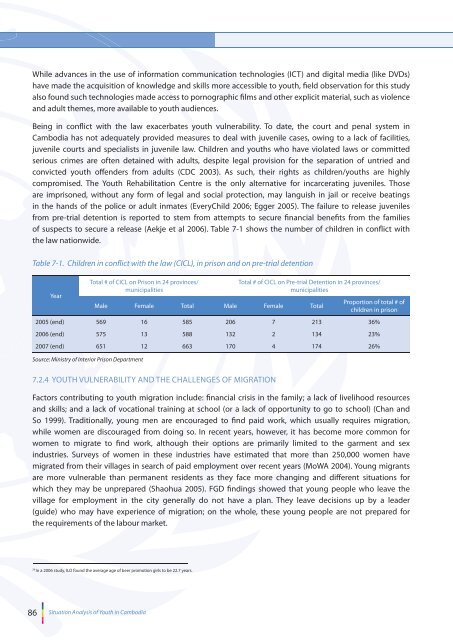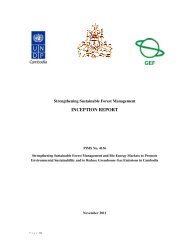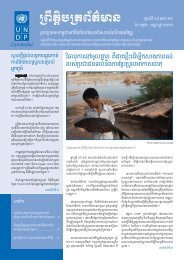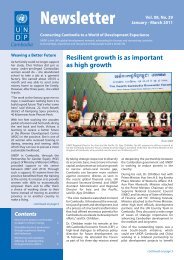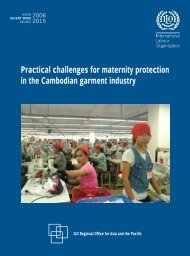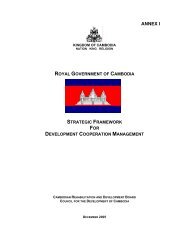UN Analysis Final.pdf - United Nations in Cambodia
UN Analysis Final.pdf - United Nations in Cambodia
UN Analysis Final.pdf - United Nations in Cambodia
Create successful ePaper yourself
Turn your PDF publications into a flip-book with our unique Google optimized e-Paper software.
While advances <strong>in</strong> the use of <strong>in</strong>formation communication technologies (ICT) and digital media (like DVDs)<br />
have made the acquisition of knowledge and skills more accessible to youth, field observation for this study<br />
also found such technologies made access to pornographic films and other explicit material, such as violence<br />
and adult themes, more available to youth audiences.<br />
Be<strong>in</strong>g <strong>in</strong> conflict with the law exacerbates youth vulnerability. To date, the court and penal system <strong>in</strong><br />
<strong>Cambodia</strong> has not adequately provided measures to deal with juvenile cases, ow<strong>in</strong>g to a lack of facilities,<br />
juvenile courts and specialists <strong>in</strong> juvenile law. Children and youths who have violated laws or committed<br />
serious crimes are often deta<strong>in</strong>ed with adults, despite legal provision for the separation of untried and<br />
convicted youth offenders from adults (CDC 2003). As such, their rights as children/youths are highly<br />
compromised. The Youth Rehabilitation Centre is the only alternative for <strong>in</strong>carcerat<strong>in</strong>g juveniles. Those<br />
are imprisoned, without any form of legal and social protection, may languish <strong>in</strong> jail or receive beat<strong>in</strong>gs<br />
<strong>in</strong> the hands of the police or adult <strong>in</strong>mates (EveryChild 2006; Egger 2005). The failure to release juveniles<br />
from pre-trial detention is reported to stem from attempts to secure f<strong>in</strong>ancial benefits from the families<br />
of suspects to secure a release (Aekje et al 2006). Table 7-1 shows the number of children <strong>in</strong> conflict with<br />
the law nationwide.<br />
Table 7-1. Children <strong>in</strong> conflict with the law (CICL), <strong>in</strong> prison and on pre-trial detention<br />
Year<br />
Total # of CICL on Prison <strong>in</strong> 24 prov<strong>in</strong>ces/<br />
municipalities<br />
Total # of CICL on Pre-trial Detention <strong>in</strong> 24 prov<strong>in</strong>ces/<br />
municipalities<br />
Male Female Total Male Female Total<br />
Proportion of total # of<br />
children <strong>in</strong> prison<br />
2005 (end) 569 16 585 206 7 213 36%<br />
2006 (end) 575 13 588 132 2 134 23%<br />
2007 (end) 651 12 663 170 4 174 26%<br />
Source: M<strong>in</strong>istry of Interior Prison Department<br />
7.2.4 YOUTH VULNERABILITY AND THE CHALLENGES OF MIGRATION<br />
Factors contribut<strong>in</strong>g to youth migration <strong>in</strong>clude: f<strong>in</strong>ancial crisis <strong>in</strong> the family; a lack of livelihood resources<br />
and skills; and a lack of vocational tra<strong>in</strong><strong>in</strong>g at school (or a lack of opportunity to go to school) (Chan and<br />
So 1999). Traditionally, young men are encouraged to f<strong>in</strong>d paid work, which usually requires migration,<br />
while women are discouraged from do<strong>in</strong>g so. In recent years, however, it has become more common for<br />
women to migrate to f<strong>in</strong>d work, although their options are primarily limited to the garment and sex<br />
<strong>in</strong>dustries. Surveys of women <strong>in</strong> these <strong>in</strong>dustries have estimated that more than 250,000 women have<br />
migrated from their villages <strong>in</strong> search of paid employment over recent years (MoWA 2004). Young migrants<br />
are more vulnerable than permanent residents as they face more chang<strong>in</strong>g and different situations for<br />
which they may be unprepared (Shaohua 2005). FGD f<strong>in</strong>d<strong>in</strong>gs showed that young people who leave the<br />
village for employment <strong>in</strong> the city generally do not have a plan. They leave decisions up by a leader<br />
(guide) who may have experience of migration; on the whole, these young people are not prepared for<br />
the requirements of the labour market.<br />
29<br />
In a 2006 study, ILO found the average age of beer promotion girls to be 22.7 years.<br />
86 Situation <strong>Analysis</strong> of Youth <strong>in</strong> <strong>Cambodia</strong>


